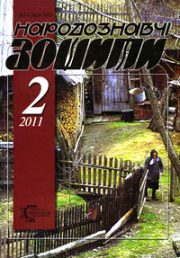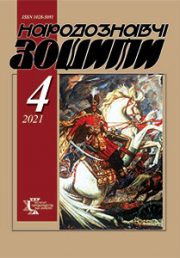The Ethnology Notebooks. 2018, № 4 (142), 929–938
UDK 75.052:27–526.62
3–99
DOI https://doi.org/10.15407/nz2018.04.929
Received 24.05.2018
Ziatyk Bohdan – PhD student, lecturer of the department of Sacral Art of the Lviv National Academy of Arts
street Kubijovycha, 38, Lviv, Lviv area, 79000
Contacts: e–mail: bohdan.sbl@gmail.com
Abstrakt. In the article, for the first time, the iconography of temple polychromes of Lviv, executed from 1990 to 2015, is considered in a comprehensive manner. According to the iconographic peculiarities of the polychrome of Lviv temples, it is divided in to two main groups: the Roman Catholic iconography (originated from the XVII century) and the second follow in from the Byzantine, which was reflected in the art of the Princely period. This articles studies the topic of polychrome iconography of Lviv temples over the period 1990–2015, belong in to the second group. The study also examines the tendencies of the iconography of temple murals, executed in a neo–Byzantine style and influenced by the style of modernism. Attention is focused on the iconography of scenes such as «The Eucharist» (Communion of the Apostles), «The Virgin of Incarnation», «The Descentinto Hell», «The Dormition of the Mother of God» and «The Christ Pantocrator», which are characteristic to the ancient Ukrainian and Byzantine traditions. The iconography of Lviv temples polychrome from 1990 to 2015 is compared with the temple murals and icons of the XI–XV centuries, on which we can see similar images.
Keywords: polychrome, Lviv temples over the period 1990–2015, iconography, art of the Princely period.
REFERENCES
Berehovs’ka, Kh. (2010). Modernyj Vizantyzm – zarodzhennia novoho styliu. Arkhitektura, budivnytstvo, inter’ier, mystetstvo, 1, 6–7 [in Ukrainian].
Vasylyk, R. (1998). Struktura vnutrishn’oho prostoru khramu v konteksti Liturhii. Visnyk L’vivs’koi natsional’noi akademii mystetstv, 9, 72–77 [in Ukrainian].
Vladyka, S. (2013). Deiaki aspekty rozvytku suchasnoho sakral’noho mystetstva (v Ukraini). Obrazotvorche mystetstvo, 4, 66–69 [in Ukrainian].
Voloshyn, L. (2012). Interpretatsiia tradytsij sakral’noho mystetstva u tvorchosti Kostia Markovycha. Visnyk L’vivs’koi natsional’noi akademii mystetstv, 23, 272–279 [in Ukrainian].
Helytovych, M. (2014). Ukrains’ki ikony XIII – pochatku XVI stolit’ zi zbirky Natsional’noho muzeiu u L’vovi imeni Andreia Sheptyts’koho: al’bom–kataloh. L’viv: Natsional’nyj muzej u L’vovi imeni Andreia Sheptyts’koho; Kyiv: Majster knyh [in Ukrainian].
Zhyshkovych, V. (2004). Mystetstvo stvorene Bohom i vo im’ia Bozhe. In Bojkivschyna: Naukovyj zbirnyk (pp. 370–415). Drohobych: Bojkivschyna, 2 [in Ukrainian].
Zapasko, Ya. (1995). Pam’iatky knyzhkovoho mystetstva: Ukrains’ka rukopysna knyha. L’viv: Svit [in Ukrainian].
Komarnyts’kyj, A.S. (2014). Obraz Bohorodytsi i khudozhnia kul’tura Kyivs’koi Rusi (stanovlennia natsional’nykh osoblyvostej) (PhD dissertation). Ivano–Frankivs’k: Prykarpats’kyj natsional’nyj universytet im. V. Stefanyka [in Ukrainian].
Kosiv, R. (2002). Obraz i tradytsiia. Ikonopys khramu sv. Volodymyra ta Ol’hy u L’vovi. Visnyk L’vivs’koi natsional’noi akademii mystetstv, 13, 151–160 [in Ukrainian].
Krekhovets’kyj, Ya. (2008). Bohoslov’ia ta dukhovnist’ ikony. L’viv: Svichado [in Ukrainian].
Krekhovets’kyj, Ya. (1999). Ikonohrafiia Pantokratora vid katakombiv do s’ohodni. Soprychastia, 65–78 [in Ukrainian].
Kukoval’s’ka, N. (2011). Mykhajlivs’kyj Zolotoverkhyj monastyr: istorychna dolia ta mystets’ka spadschyna. Kyiv: Horobets’ [in Ukrainian].
Kiuntsli, R. (2014). Povernennia ukrains’koho modernu v khramovyj rozpys ukrains’kykh tserkov. In MIST: Mystetstvo, istoriia, suchasnist’, teoriia: zbirnyk naukovykh prats’ z mystetstvoznavstva i kul’turolohii (pp. 145–154), Kyiv: Feniks, 10 [in Ukrainian].
Nikitenko, N. (2000). Sobor sviatoi Sofii v Kyievi. Kyiv: Tekhnika [in Ukrainian].
Ovsijchuk, V. (2000). Opovid’ pro Ikonu. L’viv: Instytut narodoznavstva NAN Ukrainy [in Ukrainian].
Ovsijchuk, V., & Krvavych, V. (1996). Ukrains’ke maliarstvo X–XVIII st. Problemy kol’oru. L’viv: Instytut narodoznavstva NAN Ukrainy [in Ukrainian].
Patriarkh Dymytrij, (Yarema) (2005). Ikonopys Zakhidnoi Ukrainy XII–XV stolit’. L’viv: Drukars’ki kunshty [in Ukrainian].
Protsiv, I., & Zhyshkovych V. (2016). Khram Sviatoi Anny u L’vovi. L’viv [in Ukrainian].
Rudak, O. (2014). Zobrazhennia istorychnykh osib u suchasnomu monumental’nomu tserkovnomu maliarstvi Ukrainy. Tserkva arkhystratyha Mykhaila v seli Veryn na L’vivshchyni. Naukovi zapysky ternopil’s’koho natsional’noho pedahohichnoho universytetu im. Volodymyra Hnatiuka. Seriia: Mystetstvoznavstvo, 3, 273–278 [in Ukrainian].
Rudak, O. (2015). Monumental’ni khramovi rozpysy XXI stolittia. Asotsiatsiia sakral’noho mystetstva. Perspektyvni napriamky svitovoi nauky: Zbirnyk statej uchasnykiv trydtsiat’ pershoi mizhnarodnoi naukovo–praktychnoi konferentsii «Innovatsijnyj potentsial svitovoi nauky – XXI storichchia» (25 liutoho – 1 bereznia 2015 r.). Zaporizhzhia: PHA, 1. Nauky humanitarnoho tsyklu [in Ukrainian].
Rudych, O. (2015). Tserkovni rozpysy vypusknykiv L’vivs’koi natsional’noi akademii mystetstv. Visnyk L’vivs’koi natsional’noi akademii mystetstv, 27, 181–190 [in Ukrainian].
Sydor, O. (2000). Ikonohrafiia Isusa Khrysta v davn’omu ukrains’komu mystetstvi. Kyivs’ka Tserkva: Al’manakh khrystyians’koi dumky, 5, 89–94 [in Ukrainian].
Simonova, A.V. (2015). Vizantiyskie traditsii v sovremennyih rospisyah pravoslavnyh hramov Ukrainy (konets XX – nachalo XXI vv.) (PhD dissertation). Harkov [in Russian].
Stepovyk, D. (2004). Istoriia ukrains’koi ikony X–XX st. Kyiv: Lybid’ [in Ukrainian].
Shchepkina, M. (1977). Miniatiury Hludovskoi psaltyri. Grecheskii illiustrirovannyi kodeks XI v. Moskva: Iskusstvo [in Russian].






